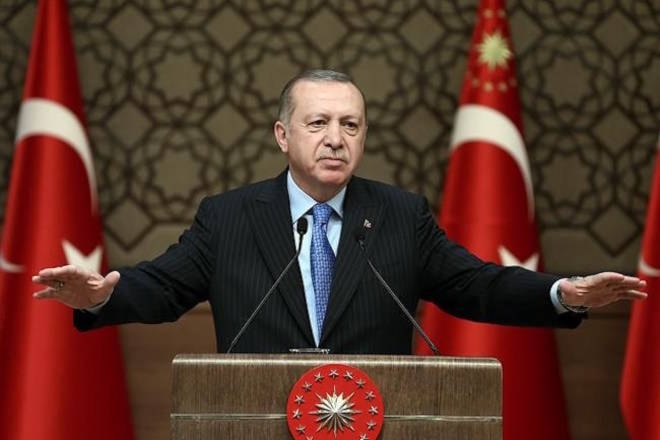Thousands of civilians streamed out of a town in Syria’s besieged, opposition-held enclave of eastern Ghouta on Thursday, crossing on foot and in pick-up trucks and tractors to government-held territory near the capital, Damascus, according to footage on state-run Syrian television.
Al-Ikhbariya TV showed men, women and children walking out of the town of Hamouria carrying their belongings, including clothes and mattresses and suitcases, some over their heads. A herd of sheep was among the crowds leaving through the crossing.
Syrian state-run Al-Ikhbariya said nearly 10,000 people left Monday — the largest civilian exodus from eastern Ghouta since the government launched a punishing assault on the rebel-held region more than three weeks ago. More than 1,200 civilians have been killed in government and Russian airstrikes and rocket fire.
The mass exit came as Syrians marked seven years since the popular uprising that sparked their country’s vicious civil war — and hours after Syrian government forces blanketed the town with airstrikes and rocket fire. Al-Mayadeen TV showed buses waiting to pick up civilians. Al-Ihkbariya said they will be taken to a centre for identification and relief.
Men interviewed by state-TV reporters heaped praise on the army and President Bashar Assad and said armed groups had humiliated them and held them against their will in eastern Ghouta. The government and rebels have traded accusations over who is blocking civilians from leaving.
The Syrian Observatory for Human Rights monitoring group put the number of those who had left eastern Ghouta so far Thursday at 9,300. It also said government forces targeted a column of civilians fleeing Hamouria before dawn Thursday, wounding several people, and that 26 people were killed in government strikes on the town on Wednesday.
The U.N. estimates that close to 400,000 people are trapped inside the government’s siege of eastern Ghouta. They are running out of room to flee as government forces close in on the space.
Meanwhile, the International Committee of the Red Cross managed to send a joint relief agencies convoy with aid for thousands of displaced into another part of eastern Ghouta, the town of Douma, the ICRC said.
According to Syrian Civil Defence, also known as White Helmets, the organization’s first responders were unable to reach the wounded in several other towns in eastern Ghouta because of the intensity of the assault. It said one of its rescue workers was killed in an airstrike on the town of Hazeh.
“They are burning Ghouta to the ground,” said Anas al-Dimashqi, a media activist and resident of Kafr Batna, a town also targeted in intense airstrikes Thursday.
Dimashqi, the White Helmets and the Syrian Observatory for Human Rights reported that government and Russian aircraft were using napalm-like incendiary weapons to spread fires in the towns.
Government and Russian forces also targeted a column of civilians trying to flee another town, Hamouria, early Thursday, according to the activists and the Observatory. At least 26 civilians were killed Hamouria on Wednesday, the Observatory said earlier.
The Syrian government, backed by its allies Iran and Russia, is determined to retake control of the once farming region just outside the Damascus, after seven years of war and bloodletting that has killed around 450,000 people and displaced millions.
More than 1,200 people have been killed since pro-government forces launched their assault on eastern Ghouta more than three weeks ago.
Damascus and Moscow have ignored a Feb. 25 U.N. Security Council resolution demanding a cease-fire for the entire country.
Related: Putin declares victory on visit to air base in Syria
The eastern Ghouta region was one of the hubs of the uprising against President Bashar Assad in 2011 and was quickly targeted for siege, mass arrests, and extrajudicial killings by security forces.
Government forces cleaved the region in two parts earlier this week, and isolated the area’s largest town, Douma, from the rest of the suburbs.
Douma has seen four days of relative calm, said local media activist Youssef Boustani.
The 25-truck aid convoy organized by the international Red Cross, the Syrian Red Crescent, and the United Nations crossed into eastern Ghouta on Thursday, according to the ICRC, and was expected to deliver aid later in the day.
Damascus routinely blocks the aid agencies from delivering relief to opposition-held areas in the country.
The Russian military, meanwhile, said it had extended a “humanitarian pause” to operations targeting Douma through Thursday and Friday. It claimed the pause has allowed growing numbers of civilians to reach safety.
Maj. Gen. Yuri Yevtushenko was quoted by the Interfax news agency as saying that 131 people left the area through the humanitarian corridor on Wednesday. Maj. Gen. Vladimir Zolotukhin said some 100 people are expected to be evacuated on Thursday.
Related: Syrian refugee makes new home in Salmon Arm
___
Associated Press writer Angela Charlton in Moscow contributed to this report.
Philip Issa, The Associated Press
